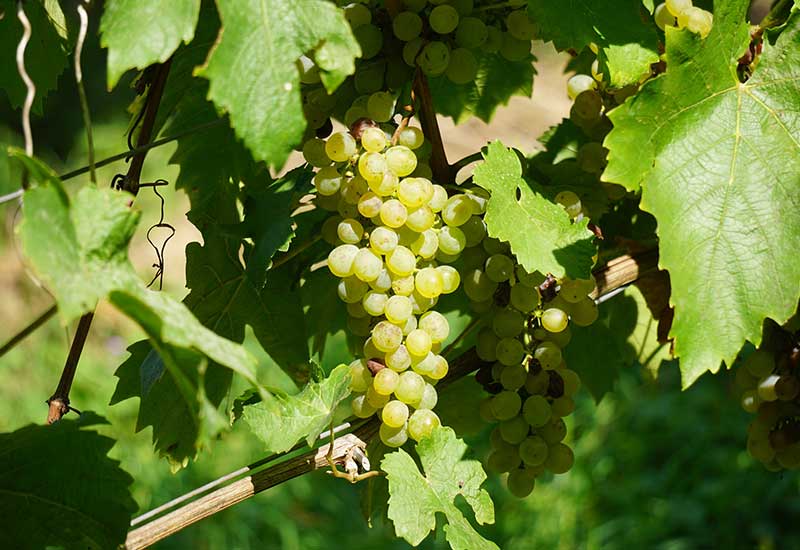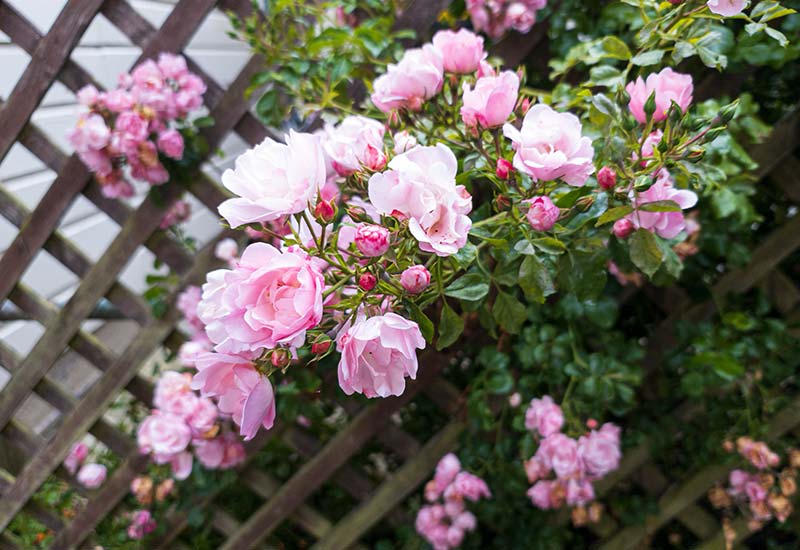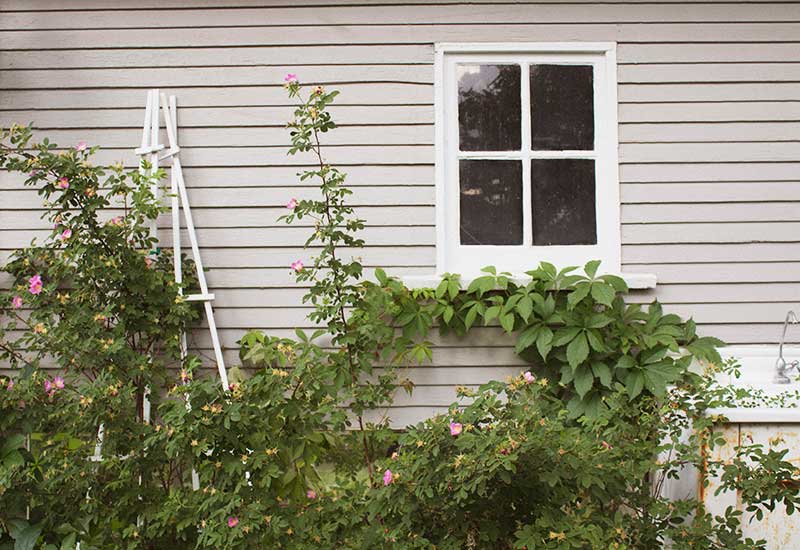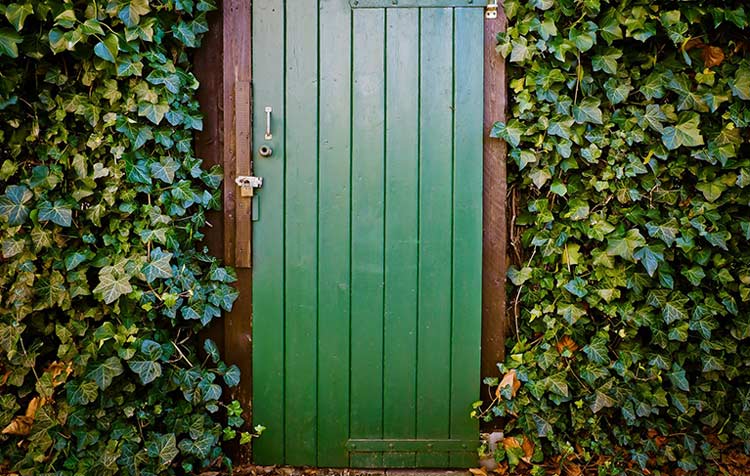You want to have your garden house overgrown and know which climbing plants are particularly suitable? Then you are absolutely right here! A green roof is, of course, already a great way to keep the make your own garden a little more sustainable and breathe species-rich life into it. But even the walls of your hut can be greened with simple means, so that new habitats and food sources for birds and insects are created.
In this article I would like to introduce you to the best self-climbers and scaffold climbers from the plant world, which are wonderfully suitable as facade greenery of your garden hut. In addition, you will receive valuable tips and finally learn which climbing plant you should rather do without. Let's go!
Here you can find a short overview in advance:
- Vines
- Akebie
- Blackberry
- Climbing hydrangea
- Climbing roses
- Trellis fruit
- Honeysuckle
- Blue rain
- Ivy
- Wild wines
1. vines

How about letting your arbor have vines and a special, mediterranean flair erzeugst? Das ist zumindest unser persönlicher Wunsch, wenn wir demnächst unser neues Gartenhaus aufbauen, da die Weinreben sehr gut an Holzbalken wachsen und als Shade giver, as well as Food source serve. (report follows)
In any case, it is important that around your garden hut. sufficient floor area free lets to plant the vines there. With Vine aids made of metal or wood, you then make sure that they pave the way for themselves.
Tip: If you'd like to see your garden shed in "green" year-round, there are evergreen varieties, such as Armands woodland vine.
2. akebie
A really low-maintenance Climbing plant is the akebia. Its climbing shoots grow upwards in an upright position and its pink flowers give a special charm to any garden house. If you create ideal conditions and plant them on relatively wind-protected walls, the climbing plant will give you a lot of pleasure.
3. blackberry
It is also important to choose climbing plants that are no damage to the wood or generally leave on building facades. These also include another climbing plant, namely the blackberry. It classifies itself with the spreading climbers, grows very luxuriantly and regularly provides fresh, edible fruits from their own garden.
4. climbing hydrangea
The popular climbing hydrangea belongs to the root-climbing self-climbers that cling to solid walls or fences with their adhesive roots. In winter it sheds its foliage, but until then it helps any garden shed to a particularly colorful overall picture.
5. climbing roses

Climbing rose is a spreader climber and provides not only greenery, but also colorful, flowering walls in the garden. Especially good are the rambler roses, because they are very fast growing and extremely robust and easy to care for are. But be sure to support the plant with a climbing aid.
6. espalier fruit
Trellis fruit refers to fruit trees that are aligned and attached to a framework. They are particularly suitable for those who do not have quite so much space in the garden, as Apple, pear, sour cherry and so many more -trees grow flat along the wall. This not only looks very good, but also provides delicious fruit at regular intervals. Certainly not an unimportant reason to let your garden house grow with it.
But it should not go unmentioned that the espalier fruit also has the appropriate Expertise and care needed.
7. honeysuckle
Extremely wall-friendly are also fast-growing climbing plants, such as honeysuckle. Whether Japanese honeysuckle, fire honeysuckle or forest honeysuckle - you can hang the plant on the wall of your garden shed. simply cut back, if it spreads too rapidly and extensively.
In terms of water requirements and location, the honeysuckle is Relatively demanding, but the blooms and fragrance in your garden help make this effort worthwhile.
8. blue vine
If you want your garden house to be overgrown, climbing plants such as the blue vine should also help you. The really bright blue and pleasantly fragrant flowers make any wall a real eye-catcher and come out especially in full sunny places.
The blue-green rain is also found in many gardens because it is flowery, healthy and fast growing is. So fast that it can become very heavy, so ideally the climbing aid is firmly attached to the wooden wall of your garden shed.
9. ivy
Wild ivy is a privacy screen, wall decoration, air humidifier and purifier all in one. In addition, he is Extremely undemanding, grows even in shady places and is beautiful green even in winter.
Its reputation has suffered somewhat because the many adhesive feet are said to damage the facade. Of course, the glaze on the wood can be somewhat affected - but the (hard) wood itself, something rarely happens. And that is why the root-climbing ivy is also very well suited, if you want to let your garden house overgrown.
Additional Tip: Did you know that you can from ivy leaves also make great dishwashing liquid can? I'll be happy to show you how it works in the linked post!
10. wild wines
We had already talked about vines. An alternative to this are wild wines, such as the maidenhair vine or the scarlet vine. They do not provide edible food, but still produce - outside the winter season - a beautiful, green / colorful overall picture the garden shed.
The plants are usually self-climbers and rather rarely need a climbing aid. However, by attaching guide cords, you can still control them the way you like.
Let garden house overgrown - No problem, right?

Each climbing plant has its own requirements. So when making your choice, also take into account location factors such as sun, wind and water and generally the Plant needs. Use climbing aids so that ivy, climbing roses and the like don't have such a hard time and grow where you want them to. To avoid damaging the wall of your garden shed, you should also avoid aggressive climbing plants such as knotweed.
I hope this article helps you green your garden shed. Do you have any questions, suggestions or further tips? Then I look forward to your comments.
Stay sustainable,

PS.: By having a greener garden, you contribute, among other things, to the Stop insect mortality. What else you can do for the protection of the little animals, you will learn in the linked article.





